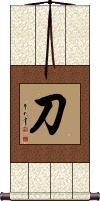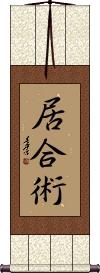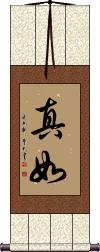Many custom options...
And formats...

Blade in Chinese / Japanese...
Buy a Blade calligraphy wall scroll here!
Personalize your custom “Blade” project by clicking the button next to your favorite “Blade” title below...
Katana
Japanese Samurai Sword
刀 is the Japanese Kanji for “sword.” This refers to the style of sword carried by warriors, samurai, and shogun of ancient Japan.
With the pacification of Japan, such swords are now only used for ceremony and decoration. The true art of sword-smithing is all but lost in Japan with new sword production dedicated to making inexpensive replicas for the tourist and foreign market.
For those of you that want to ask whether I can get you a real antique sword. Let me tell you that most real Asian swords were melted down after WWII in Japan, and during the Great Leap Forward in China. Any remaining swords are family heirlooms that nobody will part with.
Please carefully note that the Japanese kanji character shown above is only for a Japanese audience. In China, this character means “knife.” See our other entry for “sword” in Chinese.
Note: 刀 can mean knife, sword, or blade in Korean, depending on context.
See Also: Sword
Throwing Star
Iaijutsu
Sword
剱 is the modern Japanese way to write sword.
This Kanji character comes from original Chinese. This form would also be understood in Chinese (there are often several ways to write the same character) but I suggest this one only if your audience is Japanese (because they've settled on a slightly different form as the standard in China).
In Japanese, this character also means saber/sabre, blade, bayonet, stinger, and clock hand (clock hands are the “swords” of the clock).
See Also: Katana
Tathata / Ultimate Nature of All Things
真如 comes from the Sanskrit and Pali word often romanized as “tathata” or “tathatā.” Originally written, “तथता.”
It's a Buddhist term often translated as “thusness” or “suchness,” but this does not explain it.
A better explanation may be “the ultimate nature of all things” or “ultimate truth.” However, this gives it too strong of a feeling. This concept is sometimes described as being in awe of the simple nature of something - like a blade of grass blowing in the wind or ripples on water. It is what it is supposed to be, these things follow their nature. Amazing in their mundane simplicity.
Every sect of Buddhism will have a slightly different flavor or explanation, so don't get fixated on one definition.
Notes: Sometimes Buddhists use the word dharmatā, a synonym to tathatā.
In Japan, this can also be the female given name Mayuki, or the surname Majo.
Islam
(phonetic version)
伊斯蘭教 both means and sounds like “Islam” in Mandarin Chinese.
The first three characters sound like the word “Islam,” and the last character means “religion” or “teaching.” It's the most general term for “Islam” in China. The highest concentration of Muslims in China is Xinjiang (the vast region in northwest China that was called The East Turkistan Republic until 1949 and is sometimes called Chinese Turkistan, Uyghuristan). Here you will find Uygurs, Kazakhs, Kyrgyz, and others that are descendants of Turkmen (possibly mixed with Persians and Arabs). Many of their ancestors were traders who traveled the silk road to buy and sell spices and silk and exchange other goods from the Orient and the Middle East.
I spent some time in Xinjiang and got to know this community. They are strong people who can endure much. They are friendly and love to have a good time. I was a stranger but was treated by villagers (near China's border with Afghanistan) as if I was a good friend.
However, I have heard that it's best not to cross them, as in this land, the law is the blade, and everything is “eye for an eye.” The Chinese government has little control in Xinjiang, with almost no police officers except in the capital of Urumqi (so it's a 60-hour roundtrip train ride to seek the aid of law enforcement in most cases).
While few seem devout, there are at least small mosques in every village. And you will never see a man or woman outside without a head covering.
It should be noted that these people are all citizens of China, but they are officially of the Caucasian race. A visit to Xinjiang will change your idea of what it means to be Chinese.
Not the results for blade that you were looking for?
Below are some entries from our dictionary that may match your blade search...
| Characters If shown, 2nd row is Simp. Chinese |
Pronunciation Romanization |
Simple Dictionary Definition |
刀 see styles |
dāo dao1 tao katana(p); tou / katana(p); to かたな(P); とう |
More info & calligraphy: Katana(1) sword (esp. Japanese single-edged); katana; (2) (とう only) scalpel; (3) (とう only) (See 彫刻刀・ちょうこくとう) chisel; burin; graver; (4) (とう only) (See 刀銭) knife money (knife-shaped commodity money used in ancient China); (personal name) Tou sword |
剣 see styles |
jiàn jian4 chien mayaka まやか |
More info & calligraphy: Swordsword (originally esp. a doubled-edged sword); sabre; saber; blade; (1) sword (originally esp. a doubled-edged sword); sabre; saber; blade; (2) bayonet; (3) swordsmanship; (4) stinger; ovipositor; dart; (female given name) Mayaka |
劍 剑 see styles |
jiàn jian4 chien ken つるぎ |
More info & calligraphy: Sword(out-dated kanji) sword (originally esp. a doubled-edged sword); sabre; saber; blade; (out-dated kanji) (1) sword (originally esp. a doubled-edged sword); sabre; saber; blade; (2) bayonet; (3) swordsmanship; (4) stinger; ovipositor; dart A sword, a two-edged sword.; A sword, two-edged sword. |
身 see styles |
shēn shen1 shen mi み |
More info & calligraphy: Body(1) one's body; one's person; (2) oneself; one's appearance; (3) one's place (in society, etc.); one's position; (4) main part; meat (as opposed to bone, skin, etc.); wood (as opposed to bark); blade (as opposed to its handle); container (as opposed to its lid); (surname) Misaki kāya; tanu; deha. The body; the self.; Two forms of body; there are numerous pairs, e. g. (1) (a) 分段身 The varied forms of the karmic or ordinary mortal body, or being; (b) 變易身 the transformable, or spiritual body. (2) (a) 生身 The earthly body of the Buddha; (b) 化身 hinirmāṇakāya, which may take any form at will. (3) (a) 生身 his earthly body; (b) 法身 his moral and mental nature—a Hīnayāna definition, but Mahāyāna takes his earthly nirmāṇakāya as the 生身 and his dharmakāya or that and his saṃbhogakāya as 法身. (4) 眞應二身 The dharmakāya and nirmāṇakāya. (5) (a) 實相身 The absolute truth, or light, of the Buddha, i. e. the dharmakāya; (b) 爲物身 the functioning or temporal body. (6) (a) 眞身 the dharmakāya and saṃbhogakāya; (b) 化身 the nirmāṇakāya. (7) (a) 常身 his permanent or eternal body; (b) 無常身 his temporal body. (8) (a) 實身 and 化身 idem 二色身. |
手裏剣 see styles |
shuriken しゅりけん |
More info & calligraphy: Throwing Star |
乇 see styles |
zhé zhe2 che |
"blade of grass" component in Chinese characters |
刃 see styles |
rèn ren4 jen yaiba やいば |
edge of blade (1) blade; sword; (2) (See 刃文・はもん) forged blade; wavy pattern on forged blades; (3) sharpness; (4) (rare) (See 籾) unhulled rice; (personal name) Jinji A blade, a sword; to kill. |
劒 剑 see styles |
jiàn jian4 chien tsurugi つるぎ |
variant of 劍|剑[jian4] (out-dated kanji) sword (originally esp. a doubled-edged sword); sabre; saber; blade; (out-dated kanji) (1) sword (originally esp. a doubled-edged sword); sabre; saber; blade; (2) bayonet; (3) swordsmanship; (4) stinger; ovipositor; dart; (surname) Tsurugi |
峯 峰 see styles |
fēng feng1 feng mine みね |
old variant of 峰[feng1] (1) peak; summit; ridge; top; (2) back of a blade; (surname, female given name) Mine mountain peak |
峰 see styles |
fēng feng1 feng minezaki みねざき |
(of a mountain) high and tapered peak or summit; mountain-like in appearance; highest level; classifier for camels (1) peak; summit; ridge; top; (2) back of a blade; (surname) Minezaki peak |
嶺 岭 see styles |
lǐng ling3 ling rei / re れい |
mountain range; mountain ridge (1) peak; summit; ridge; top; (2) back of a blade; (surname, female given name) Rei |
戟 see styles |
jǐ ji3 chi geki げき |
halberd; long-handled weapon with pointed tip and crescent blade; combined spear and battle-ax ji (ancient Chinese halberd) |
樋 see styles |
toi; hi; toyo; toyu とい; ひ; とよ; とゆ |
(1) trough; gutter; water pipe; flume; chute; (2) (ひ only) coulisse (of a sword blade); (surname) Hidaka |
胛 see styles |
jiǎ jia3 chia kaigane かいがね |
shoulder blade (archaism) (See 肩甲骨) shoulder blade; scapula; (given name) Kō |
芒 see styles |
máng mang2 mang nogi のぎ |
awn (of cereals); arista (of grain); tip (of a blade); Miscanthus sinensis (type of grass); variant of 邙, Mt Mang at Luoyang in Henan arista; awn; (grain) beard |
茦 see styles |
cè ce4 ts`e tse |
pointed grass blade; to prick |
鉈 铊 see styles |
tā ta1 t`a ta nata; nata なた; ナタ |
thallium (chemistry) nata; sturdy broad-bladed knife, used in woodcraft and hunting (often with a rectangular blade) |
鋭 锐 see styles |
ruì rui4 jui ei / e えい |
Japanese variant of 銳|锐 (noun or adjectival noun) (1) (ant: 鈍・どん) sharpness; (2) sharp weapon; blade; (3) fine soldier; (given name) Toshi sharp |
錍 see styles |
pī pi1 p`i pi |
flat arrow-head; plow blade; also pr. [pi2] |
鍔 锷 see styles |
è e4 o tsuba つば |
blade edge; sharp (1) guard on sword, polearms, etc.; flange; (2) brim; visor (e.g. of a hat); (surname) Tsuba |
鎬 镐 see styles |
hào hao4 hao shinogi しのぎ |
bright; place name; stove (1) (kana only) ridge on the side of a sword blade; (2) (kana only) {archit} ridged pattern; (personal name) Kō |
鎺 see styles |
habaki はばき |
metal collar mounted between a sword blade and the hand guard |
髆 see styles |
bó bo2 po haku |
shoulder blade shoulder blade |
一刀 see styles |
ittou; hitokatana / itto; hitokatana いっとう; ひとかたな |
(1) (いっとう only) sword; blade; (2) single stroke; (surname) Itsutou |
両刃 see styles |
ryouba / ryoba りょうば moroha もろは |
(can be adjective with の) (1) double-edged; (2) double-edged blade |
中味 see styles |
nakami なかみ |
(noun - becomes adjective with の) contents; interior; substance; filling; (sword) blade |
中身 see styles |
nakami なかみ |
(noun - becomes adjective with の) contents; interior; substance; filling; (sword) blade |
兵刃 see styles |
bīng rèn bing1 ren4 ping jen heijin / hejin へいじん |
(bladed) weapons sword blade |
刀刃 see styles |
dāo rèn dao1 ren4 tao jen toujin / tojin とうじん |
knife blade; crucial point sword blade |
刀片 see styles |
dāo piàn dao1 pian4 tao p`ien tao pien |
blade; razor blade; tool bit |
Click here for more blade results from our dictionary
The following table may be helpful for those studying Chinese or Japanese...
| Title | Characters | Romaji (Romanized Japanese) | Various forms of Romanized Chinese | |
| Katana | 刀 | katana | dāo / dao1 / dao | tao |
| Throwing Star | 手裏剣 | shu ri ken / shuriken | ||
| Iaijutsu | 居合術 | i ai jutsu / iaijutsu | ||
| Sword | 剱 剣 | ken | jiàn / jian4 / jian | chien |
| Tathata Ultimate Nature of All Things | 真如 | shinnyo | zhēn rú / zhen1 ru2 / zhen ru / zhenru | chen ju / chenju |
| Islam | 伊斯蘭教 伊斯兰教 | yī sī lán jiào yi1 si1 lan2 jiao4 yi si lan jiao yisilanjiao | i ssu lan chiao issulanchiao |
|
| In some entries above you will see that characters have different versions above and below a line. In these cases, the characters above the line are Traditional Chinese, while the ones below are Simplified Chinese. | ||||
Successful Chinese Character and Japanese Kanji calligraphy searches within the last few hours...









